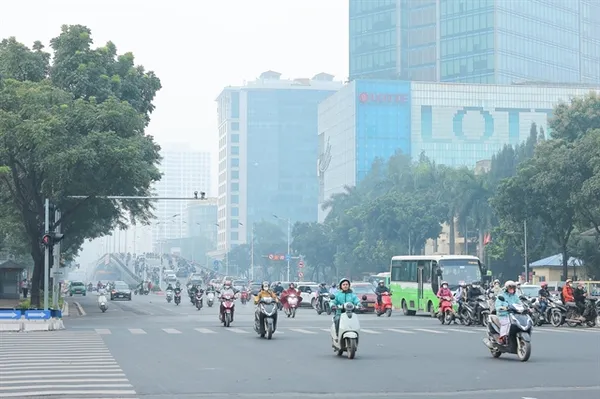 Environment
Environment

Châu Trần Vĩnh, deputy head of the Department of Water Resources Management under the Ministry of Natural Resources and Environment talks to Vietnam News Agency about how to sustainably manage water resources while climate change has triggered drought and salinity intrusion for coastal plains as well as seriously affected the daily lives of local people.

|
| Châu Trần Vĩnh, deputy head of the Department of Water Resources Management under the Ministry of Natural Resources and Environment. Photo courtesy of the Department of Water Resources Management |
Châu Trần Vĩnh, deputy head of the Department of Water Resources Management under the Ministry of Natural Resources and Environment talks to Vietnam News Agency about how to sustainably manage water resources while climate change has triggered drought and salinity intrusion for coastal plains as well as seriously affected the daily lives of local people
Could you tell us about the recent hot weather in the central region?
The central region has suffered heat waves since April. Many places reportedly had record temperatures (some localities had temperatures of over 40 degrees Celsius). Accordingly, the flow in the basins is 35-60 per cent lower than the average amount of many previous years. In the face of prolonged hot weather, reservoirs are forced to increase the amount of water for electricity generation to ensure power supply to the national grid. This causes the water level in the reservoirs to drop, with several reservoirs falling below the dead storage, including reservoirs of Trung Sơn, Hủa Na, Sông Tranh 2, Sông Ba Hạ and Ka Nak.
Additionally, the flow in most major rivers in the central and central highlands is 15-50 per cent lower than the average of the same period over previous years. The number is 55-80 per cent in rivers in provinces of Nghệ An, Hà Tĩnh, Thừa Thiên Huế and Phú Yên. The water level of large reservoirs in the regions has also been at a low level.
In response to the water shortage, reservoirs have to reduce their water discharge and actively store water to ensure the water supply for downstream areas according to the regulations of inter-reservoir operation procedures.
In a related movement, the Ministry of Natural Resources and Environment has ordered localities to actively store water; efficiently use water and make plans to regulate water for the downstream areas of river basins. The ministry has also directed operators of hydroelectric reservoirs to closely work with local administrations to ensure water supply for the downstream areas until the end of the dry season in localities of Nghệ An, Quảng Nam, Đà Nẵng, Gia Lai and Phú Yên. The ministry requires some reservoirs to prepare for providing water for local residents if severe drought occurs.
The dry season usually starts in January and ends in July in the central region, and starts in November and ends in April in the regions of south and central highlands.
How is the department running reservoirs under the inter-reservoir operation process to ensure water supply for lowland areas this year?
To ensure water supply for the lowland areas in this year’s dry season, the ministry urged the People’s Committees of localities to ask sectors and relevant agencies to store enough water. For the river basin of Vu Gia – Thu Bồn, the ministry told Đà Nẵng Water Supply Joint Stock Company to properly regulate water and fully exploit water from An Trạch dam, especially when water in the Cầu Đỏ River suffers salinity, in order to ensure water supply for residents of Đà Nẵng City.
Moreover, the ministry required authorised agencies to closely monitor the process of inter-reservoir operation in the central region. The agencies had to carefully calculate and balance the amount of water to reasonably discharge in reservoirs of river basins of Cả, Ba, Trà Khúc, especially Vu Gia –Thu Bồn river basin which often suffers drought and salinity intrusion.
Additionally, the department also approved a project of the People’s Committee of Đà Nẵng to use water in local hydroelectric reservoirs to supply local residents in the dry season.
The department has planned to provide maps and documents about underground water as well as technical assistance, manpower and equipment for localities to dig more wells and find water sources to prevent drought in affected areas.
What can the ministry do to better manage water resources?
The ministry has submitted to the Government 11 processes of inter-reservoir operation in major river basins, encompassing rivers of Hồng (Red), Mã, Cả, Hương, Vu Gia – Thu Bồn, Trà Khúc, Kôn, Ba, Sê San, Sê-rê-pôc and Đồng Nai. The processes have been applied promptly, playing a key role in improving the effectiveness of water regulation in reservoirs. It helps minimise floods affecting people living in downstream of the reservoirs and gives them a chance to access water supply for daily life and crop production.
The department is co-operating with relevant sectors to develop a master plan for water-resource survey and a project to research water sources for people in remote and mountainous areas. It is expected to help better manage water resources in the country.
The department will finish the online automatic monitoring system to track activities of exploiting and using water in localities soon. VNS




